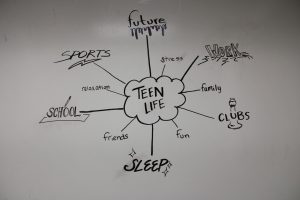The Rise of a Digital Age
Built From the Ashes of Print Media
November 6, 2019
Walking through the hallways, you can’t go more than five feet without seeing a multitude of phones and airpods, screens lighting faces with a bluish glow. It’s a testament to the rise of a digital age. Social media has rooted itself in our lives and online news is more prevalent than ever. Meanwhile, print media has faded into the background, the ghost of a new, fast-moving digital media movement.
No longer do plastic-wrapped newspapers lie waiting in driveways. Instead, news headlines lurk among phone notifications and Twitter feeds.
“We’re [a] headline culture now…We read the headline, and then we move on,” English teacher Kim Torpey said.
And all over the world, we’re increasingly seeing this trend. The slow death of print media is a result of cultural change, a change that has begun to have visible effects on nearly every aspect of society. Politics, education, business, and of course, pop culture -just to name a few- have all felt the effect of print media’s downfall.
In politics, “The media is so fragmented that trying to discern any ‘truth’ is getting more and more difficult,” Jack Kennedy, Executive Director of Colorado Student Media Association, said. Kennedy also says, “The most successful politicians are finding ways to pare down their messaging to as simple a form as they can,” which he says allows their listeners to feel like they understand the issues the politician discusses.
Simple, fast, convenient: three words that epitomize the cultural change brought about by the rise of a digital age. Living embodiments of this include household names like McDonald’s, Amazon, and Apple, monopolies whose products and brands are everywhere.
And as a major piece of American democracy, as well as world function, the media has had to adapt to the cultural change to survive. News outlets churn out stories at a remarkable pace, creating headlines and images that will hold the short attention span of viewers for as long as possible. They have survived -and thrived- by capitalizing on consumer culture, often in a way that portrays information as a product to be sold in order to meet the demands of the public.
“I think when we look at information as a commodity to sell, then what we’re doing is we’re impacting future generations’ ability to critically think,” Torpey said. As an educator of the digital age generation, she says she doesn’t see a thirst for knowledge anymore. And electronic media, which increasingly prioritize convenience over credibility and quantity over quality, may play a part.
“Becoming truly educated requires people to “deep dive” into topics and explore various points of view,” Kennedy said. “Social media never requires a deep dive into any topic… in fact, the most effective forms of social media involve memes or short videos.”
And indeed, critical thinking is a product of how information is presented and consumed by an individual, not just a product of a thirst for knowledge.
If the only information an individual chooses to consume comes from a five word headline, their information and ability to think critically and learn is limited. Or if they choose to read an entire article, but don’t recognize the implicit bias of the piece, their information and critical thinking is again limited.
In the modern world, vast quantities of information are at our fingertips -literally. If you don’t know something, just ask Google. Yet this can create an issue of credibility.
“In a sense, that was the job of a daily newspaper for many years: to sort through the endless facts and events and find patterns, determine what was important for that day, and highlight certain trends.” Kennedy said, in explaining the importance of “gatekeepers”, which are the people that gather, analyze, and sort the information that will eventually be shared through media.
Particularly after Nixon’s Watergate scandal, one of the media’s primary functions is as a “watchdog” to guard or protect the people by giving them access to information they have the right to know -whether it’s a political scandal or a warning about the dangers of a new product. This has not changed with the transition from print to digital media.
“It’s not that I think digital is worse and newspapers are better, but it’s not about that,” teacher Paige Gilbert said. “When you look at societies…one of the things you need for a vibrant democracy is communication.”
Media is our country’s -and our world’s- form of communication, and it has a direct impact on countless people’s thoughts and opinions. And so, of course, it also has an impact on governmental policies and the actions of the people. The media, in print or electronic, chooses which stories are put out to the people, and thus influence people’s political and personal decisions. When it comes to controversial stories; however, the reaction to print stories and online stories can be very different.
“Protesters used to burn buildings as opposed to posting hateful memes on social media.” Kennedy said. This suggests that digital media, while volatile at times, can be a useful outlet for heated exchanges.
And it has other advantages as well. The immediacy of news afforded by electronic media is vastly helpful in many cases. Knowing about major events almost immediately helps garner support and awareness that is unparalleled by print media.
The death of print media is undeniably happening. But what effects its death will have are still unfolding as electronic media rises to take its place. Both have their advantages and disadvantages, some yet to be realized. But can there be a “happy medium” between the two?
Gilbert believes there can be, saying “I think we’re going to figure that out as a culture… the legitimacy behind it and why we need it and how it drives us as thinkers and participants.”
But as for now, Jack Kennedy says, “We are what our phones reflect, by and large.”







